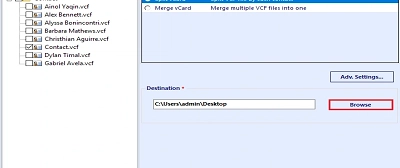VCF files (vCard files) are commonly used for storing contact information such as names, phone numbers, addresses, and email addresses. These files are widely supported by many applications and platforms, such as email clients, address books, and mobile phones. However, as the number of contacts grows, these files can become large and unwieldy, making them difficult to manage. This is where splitting a VCF file comes in handy.
If you're looking for ways to reduce VCF file size into smaller, more manageable pieces, you're in the right place. In this blog post, we'll guide you through the process of splitting a VCF file and explain why it can be beneficial for users. We'll cover everything from manual methods to automated tools, so you can choose the best method based on your needs.
Why Do VCF Files Get So Large?
Before diving into how to split a big file into smaller parts, it's important to understand why VCF files become large in the first place. Several factors contribute to the growing file size:
- Number of Variants: The more variants you analyze, the larger the VCF file becomes. Whole-genome sequencing or exome sequencing projects can generate millions of variants across hundreds or thousands of samples.
- Metadata and Annotations: VCF files may contain extensive metadata about the variants, such as quality scores, allele frequencies, and functional annotations, which add to the file size.
- Multisample Data: VCF files that include data from multiple samples can grow in size very quickly. Each sample typically requires its own line or set of information, and with large cohorts, the file can easily exceed gigabytes.
- Uncompressed Format: VCF files are often stored in plain text, which is not compressed and can result in large file sizes.
Reducing the size of VCF files is crucial for ease of storage, faster analysis, and smoother sharing with collaborators.
What is the Methods to Reduce VCF File Size?
There are several ways to split a vCard file, depending on your preferences and technical expertise. Below, we'll explore different methods that can help you achieve your goal.
Reduce Size of VCF File - Manually
If you're working with a relatively small VCF file, you can split it manually. VCF files are typically text-based files, so you can open them in a text editor and split them into smaller files.
Use a text editor like Notepad (Windows), TextEdit (Mac), or any other text editor of your choice.
Open your VCF file by clicking "File" > "Open" and selecting the VCF file you want to split.
VCF files store each contact's information within a set of markers, such as BEGIN:VCARD and END:VCARD.
Each contact's information will be enclosed between these two markers. For example:
BEGIN:VCARD
VERSION:3.0
FN:John Doe
TEL:123-456-7890
EMAIL:johndoe@example.com
END:VCARD
- Find the contact entries (beginning with BEGIN:VCARD and ending with END:VCARD) and copy them.
- Paste each contact's details into a new VCF file. Save each new file with a different name, such as contacts_part_1.vcf, contacts_part_2.vcf, etc.
- Continue copying and pasting the contacts into separate files until you’ve split the entire VCF file into smaller segments.
- Once you've split the file, save each smaller VCF file and test them by importing them into your contact manager or application to ensure they work correctly.
Advantages of Manual Splitting
- Simple and straightforward for small files.
- No need for additional software or tools.
Disadvantages of Manual Splitting:
- Time-consuming for large files.
- Prone to human error, especially with large numbers of contacts.
Reduce VCF File Size - Using VCF File Splitter Tool
If you're dealing with a large VCF file, manually splitting the file can be tedious. Fortunately, there are dedicated tools that can help automate this process. One of the most popular tool is SysTools vCard Splitter Tool.
Steps to Split a vCard File into Smaller Parts
- Download the tool VCF File Splitter on your system.
- Choose how you want to split the file. You can split it based on the number of contacts per file or based on the file size.
- Press the "Split" button. The tool will automatically divide the large file into smaller VCF files.
- After the splitting process is complete, you can save the smaller files to your desired location.
Conclusion
By following the above guide, you’ll be able to reduce VCF file size quickly and efficiently, making it easier to manage your contacts, back up important information, or share specific segments of your contact list with others.



Top comments (1)
Some comments may only be visible to logged-in visitors. Sign in to view all comments.